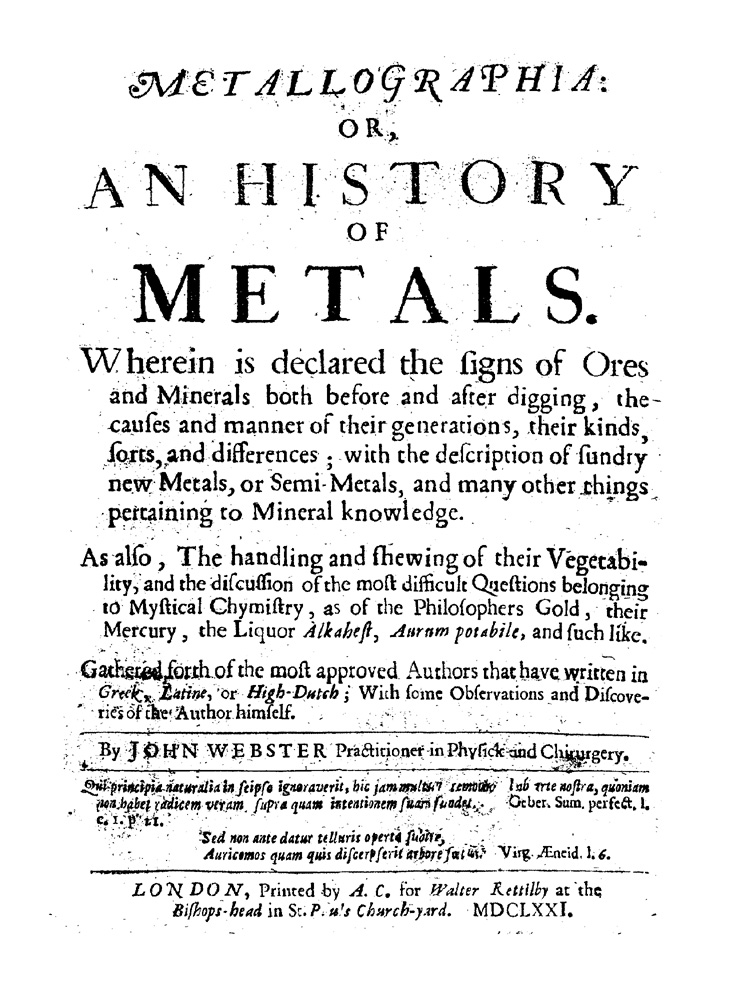WEBSTER, John.
(1610 – 1682)
He sometimes wrote under the Latinized name, "Johannes Hyphastes." Webster probably attended Cambridge. In 1634, he became curate of Kildwick in Craven, and in 1643, master of Clitheroe grammer school. He was a chaplain and surgeon in the parlimentary army. By 1653, various accounts say he became a popular preacher and theological disputant in London. He is best remembered for his The Displaying of Supposed Witchcraft (London, 1677) that attacked the existance of witches and warlocks and their dark practices.
Biographical references: Allibone, Dictionary of English Literature, 1859-71. • BBA: I 1144, 221-222. • Debus, A.G., Science and Education in the Seventeenth Century: The Webster-Ward Debate. London, 1970: 1-65. • DNB: 40, 125 [by W. Porter]. • Jobe, T.H., "The Devil in Restoration Science: the Glanvill-Webster Witchcraft Debate", Isis, 72, (1981), 342-56. • Watt, Bibliotheca Britannica, 1824. • WBI.

1. English, 1671.
Metallographia: | Or, | An History | Of | Metals. | Wherein is declared the signs of Ores | and Minerals both before and after digging, the | causes and manner of their generations, their kinds, | sorts and differences; with the description of sundry | new Metals, or Semi-Metals, and many other things | pertaining to Mineral knowledge. | As also, The handling and shewing of their Vegtabi- | lity, and the discussion of the most difficult Questions belonging | to Mystical Chymistry, as of the Philosophers Gold, their | Mercury, the Liquor Alkahest, Aurum potabile, and such like. | Gatheres forth of the most approved Authors that have written in | Greek, Latine, or High Dutch; With some Observations and Discov- | eries of the Author himself. | [rule] | By John Webster Practitioner in Physick and Chirurgery. | [rule] | [...5 lines of quotation in latin...] | [rule] | London, Printed by A.C. for Walter Rettilby at the | Bishops-head in St. Pauls Church-yard. MDCLXXI.
4°: A-Z4 2A-2Z4 3A-3D4 3E3; 203l.; [16], 1-388, [2] p. Page size: 192 x 142 mm.
Contents: [2 pgs], Title page, verso blank.; [4 pgs], Dedication to Prince Rupert, signed Jo[hn]. Webster.; [7 pgs], "The Preface."; [3 pgs], "A Register of the Chapters."; 1-388, Text.; [2 pgs], "Books printed for, and Sold by | Walter Rettilby, at the Bi- | shops-Head in Duck-Lane.
Very scarce. The Metallographia: or, an History of Metals is dedicated to Prince Rupert. It praises Bernard Trevisan, Basil Valentine, Paracelsus and Van Helmont, and belongs as much to the history of alchemy as to that of mineralogy. As its full fftle shows, it is devoted in large part to "the discussion of the most difficult questions belonging to mystical chemistry, as of the Philosophers' gold, their Mercury, the liquor Alkahest, aurum potaWle, and such like." The early pages of the volume are devoted to a critical bibliography of those authors that have treated of metals and minerals. It divides them into three groups: the speculative, who have produced more chaœf than corn; the mystical or chymists; and experimental observers. Morhof two years later criticized Webster's book as largely taken from Gernan authors with a few observations of his own. Boyle's Sceptical Chymist is not mentioned, while the alchemical views of Rhumelius are set forth at some length in the eighth chapter. Eighteen chapters are then devoted to the seven metals; chapter 27, to antimony, bismuth, zinc and cobalt; chapter 28, to cadm a, chrysocolla, caeruleum, aerugo, talc, the magnet, bloodstone, schist, lapis lazuli, etc.; and the final chapter, to transmutation. A contemporary reviewer was impressed by the apparent inconsistency that, while drinking the scrapings of rusty brass is fatal to many animals, driving a brass nail into meat and especially game keeps it from decay.
Webster supports the view that metals and minerals originate from "seeds" growing within the earth, much as plants grow on the surface. He collects together a great deal of information from old and contemporary authors including some Germans and adds his own observations.
Facsimile reprint, c1978: Metallographia: or, An History of Metals. New York, Arno Press, c1978. ISBN: 0405104626.
Bibliographical references: Adams, Birth and Development, 1938: 290-1. • Cole, Chemical Literature, 1988: no. 1353. • Duveen, Bibliotheca Alchemica et Chemica, 1965: p. 611. • Ferguson, Bibliotheca Chemica, 1906: 2, 532. • Freilich Sale Catalog: no. 545. • Hoover Collection: no. 867. • Journal des Scavans: 6 (1678), 303. • LKG: XVI 52. • Partington, History of Chemistry, 1961-70: 2, 112. • Thorndike, History of Magic, 1923-58: 7. 263-4.
.